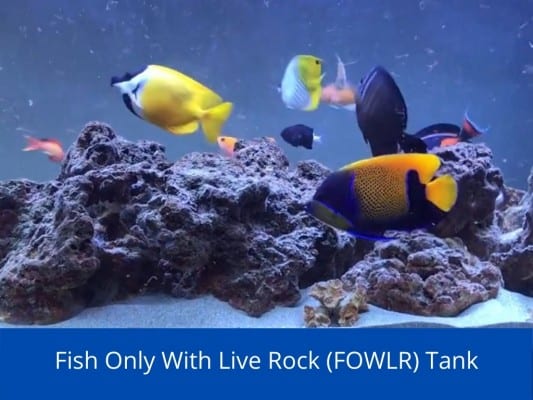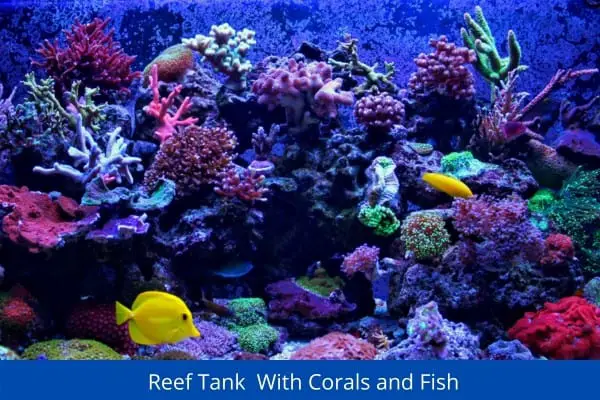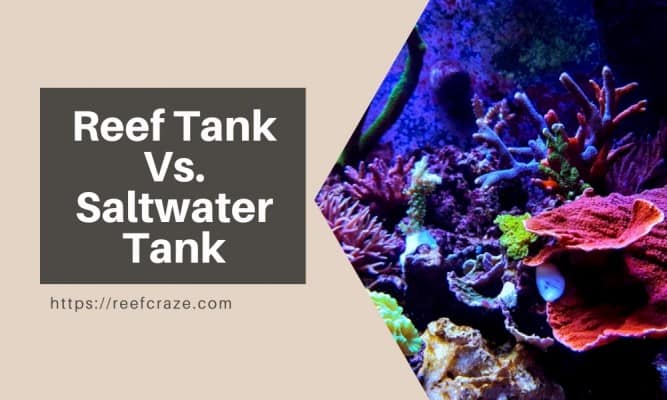If you are planning to set up a tank, I am sure you already have a lot of confusion about which type of tank to buy, which type of fish or invertebrate to choose for a tank, how to set up a tank, and other stuff. Because there are so many types of tanks available that it is quite difficult to distinguish one from another and choose the right fish/invertebrates for a tank. It often happens when one has to distinguish between a saltwater tank and a reef tank. But the main difference between a reef tank and a saltwater tank is pretty straightforward.
A saltwater tank can be of different types, and a reef tank is one of them. That means a saltwater tank has varieties. But a reef tank is a specialized saltwater tank that is for corals, fish, and invertebrates.
Since the basic difference is clear to you now, you might be interested to know the other differences too, right? Oh yes, there ARE other differences that you should know!
Keep reading!
What Is A Saltwater Tank?
Let’s start with the saltwater tank. While we talk about this one, the reef tank will automatically get into the discussion.
It starts as a simple tank of water into which an aquatic environment is created for keeping aquatic lives. You can keep the same tank for years and face no problems if you take care of it regularly.
A saltwater tank comes in different types and setups. Some require high maintenance while others are quite easy to maintain. You must know what the types are and why they are different before you make a decision of buying a tank.
Basically, there are 3 types of saltwater tanks. One is a Fish-Only (FO) tank, another is a Fish-Only-With-Live-Rock (FOWLR) tank, and the other is a Reef tank.
1. Fish-Only (FO) Tanks
Fish-only tanks are the simplest form of saltwater tanks. The name says all about its type. An FO tank is designed to house and showcase sea fish. This strictly means that you CANNOT have other invertebrates in this tank.
Since the main part of the tank is fish, the decoration of the tank is sparsely made with coral replicas or skeletons. Like any type of aquarium, the key to maintaining this tank successfully is keeping the water parameters stable and installing an effective filtration system.
Yellow tangs, damselfish are great choices for an FO tank. If you are a beginner, you should begin your aquarium experience with an FO tank.
2. Fish-Only-With-Live-Rock (FOWLR) Tanks

This tank can be referred to as the hybrid version of a fish-only tank and a reef tank. While it has the fish of an FO tank, there are also the basic elements of a reef tank introduced in this one – live rock.
Live rocks are fragmented pieces of rocks that are biologically active calcium-based. They are naturally colonized by sponges, invertebrates, and millions of beneficial nitrifying bacteria. They provide supplemental filtration while helping to keep the water parameters stable.
Besides, they add a new look to the basic saltwater tank. This also means that maintaining this tank is quite different from maintaining an FO tank. The setup of this tank will require you to cure the live rocks, add lighting or supplements to cultivate coralline algae, and stop using different types of medications that can be harmful to the beneficial life residing in the rocks.
3. Reef Tanks

See? This one is already in the discussion of saltwater tanks. Reef tanks are the most expensive and challenging type of saltwater tanks. Because unlike the other two, reef tanks are designed to house coral, fish, and other invertebrates.
Corals and invertebrates are the main parts of a reef tank. Since the invertebrates are sensitive to the conditions of water, the water parameters have to be observed and maintained regularly.
Also, corals are photosynthetic which means you have to provide them with adequate lighting so that they can survive. The inhabitants of a reef tank require a lot of care and attention. So, it is necessary that you research water movement, supplementation, lighting, and other requirements; and gain sufficient knowledge about them before you decide to buy a reef tank.
Now, the difference is much clearer. While FO and FOWLR tanks are only for fish, reef tanks are for all – corals, fish, and invertebrates. The other differences are mainly based on the inhabitants that these tanks house. Let’s dive into the details now.
Saltwater Tank vs Reef Tank

Differences In Water Parameters
The suggested level of specific gravity for FO and FOWLR tanks is 1.020-1.025 whereas it is 1.023-1.025 for reef tanks.
The suggested levels of nitrates and phosphates for FO and FOWLR tanks are less than 30.0 ppm and less than 1.0 ppm respectively. For reef tanks, the nitrate level is less than 1.0 ppm and the phosphate level is less than 0.20 ppm.
For reef tanks, suggested magnesium, iodine, and strontium levels are 1250-1350 ppm, 0.06-0.10 ppm, and 8-14 ppm respectively. For the other two, the levels are 1150-1350 ppm (magnesium), 0.04-0.10 ppm (iodine), and 4-10 ppm (strontium).
Differences In Lighting System
Lighting is not really important for a fish-only saltwater tank. But it is important for a FOWLR tank as it contains live rock. Lighting is needed for the growth of photosynthetic algae and microorganisms living in the live rocks. In a FOWLR tank, 1 or 2 watt light per gallon of water is recommended. If the lighting is high-powered, you should use an auxiliary fan to help keep the environment cool.
In a reef tank, lighting is a must. Because corals need proper lighting to survive. Here, the suggested level of lighting is 3.5 watts for every gallon of water for soft corals. For hard corals (both LPS and SPS), 4.5 watts will do. To know more in depth, check this article.
Differences In Filtration System
Water quality is a very important thing for each of the saltwater tanks. For that, a quality filtration system is needed for all of them. For FO and FOWLR tanks, you have to ensure a good quality setup for filtration systems. The better the filtration is, the healthier the tank inhabitants are.
For reef tanks, there should be a high-quality filtration system. Because corals have little tolerance for phosphates, nitrates, and other toxins that fish and invertebrates can withstand. Keeping the water quality stable is a fundamental requirement for a reef tank. So, the filtration system of a reef tank has to be way better than that of other saltwater tanks.
Differences In Water Circulation
Water circulation or water flow is also important for tank inhabitants. However, it also depends on the type of tank you have.
Fish-only tanks usually require the lowest flow. 15x to 20x turnover should be enough flow for them. FOWLR tanks require more flow to ferry the nitrates towards the live rocks. 20x turnover is the minimum requirement for this kind of tank. In case of a reef tank, the flow will start at 20x turnover but it can increase to 100x turnover varying with the type of coral.
To know more check these articles –
Final Words
From this discussion, one thing has become very clear and I am sure you can already guess that.
It is that a reef tank is more complex than the other saltwater systems in every aspect – from the types of sea animals to the parameters of water. The other two are quite easy maintenance. But a reef tank needs extra effort as it shelters sensitive sea animals like corals.
However, now that you know the differences between the basic saltwater tanks and the reef tank, you will be able to make an informed decision if you want to buy a saltwater tank or reef tank for yourself.
And hopefully, you will be successful in maintaining it. Best wishes!
